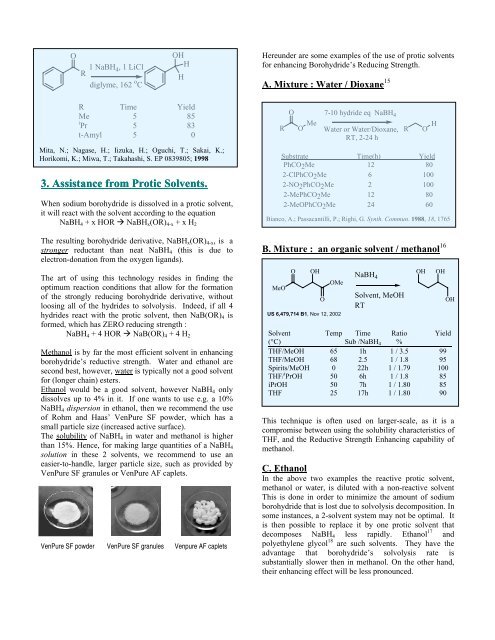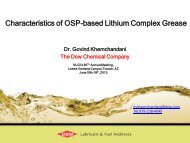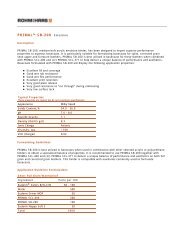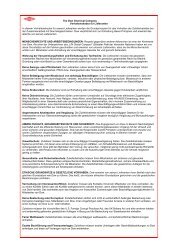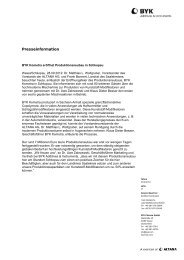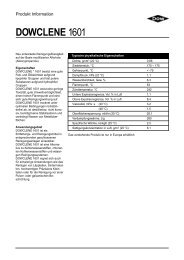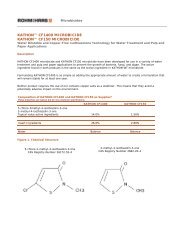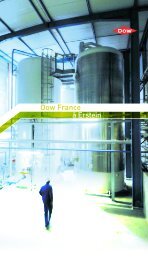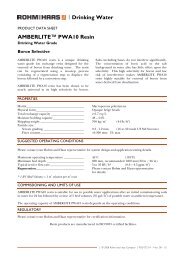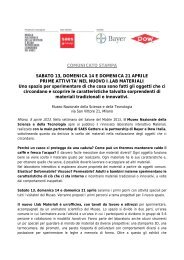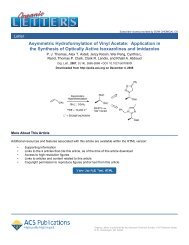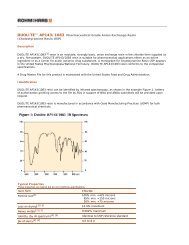VenPure® solution - The Dow Chemical Company
VenPure® solution - The Dow Chemical Company
VenPure® solution - The Dow Chemical Company
You also want an ePaper? Increase the reach of your titles
YUMPU automatically turns print PDFs into web optimized ePapers that Google loves.
O<br />
1 NaBH4, 1 LiCl<br />
R<br />
diglyme, 162 o C<br />
OH<br />
H<br />
R Time Yield<br />
Me 5 85<br />
i Pr 5 83<br />
t-Amyl 5 0<br />
Mita, N.; Nagase, H.; Iizuka, H.; Oguchi, T.; Sakai, K.;<br />
Horikomi, K.; Miwa, T.; Takahashi, S. EP 0839805; 1998<br />
3. Assistance from Protic Solvents.<br />
When sodium borohydride is dissolved in a protic solvent,<br />
it will react with the solvent according to the equation<br />
NaBH4 + x HOR � NaBHx(OR)4-x + x H2<br />
<strong>The</strong> resulting borohydride derivative, NaBHx(OR)4-x, is a<br />
stronger reductant than neat NaBH4 (this is due to<br />
electron-donation from the oxygen ligands).<br />
<strong>The</strong> art of using this technology resides in finding the<br />
optimum reaction conditions that allow for the formation<br />
of the strongly reducing borohydride derivative, without<br />
loosing all of the hydrides to solvolysis. Indeed, if all 4<br />
hydrides react with the protic solvent, then NaB(OR)4 is<br />
formed, which has ZERO reducing strength :<br />
NaBH4 + 4 HOR � NaB(OR)4 + 4 H2<br />
Methanol is by far the most efficient solvent in enhancing<br />
borohydride’s reductive strength. Water and ethanol are<br />
second best, however, water is typically not a good solvent<br />
for (longer chain) esters.<br />
Ethanol would be a good solvent, however NaBH4 only<br />
dissolves up to 4% in it. If one wants to use e.g. a 10%<br />
NaBH4 dispersion in ethanol, then we recommend the use<br />
of Rohm and Haas’ VenPure SF powder, which has a<br />
small particle size (increased active surface).<br />
<strong>The</strong> solubility of NaBH4 in water and methanol is higher<br />
than 15%. Hence, for making large quantities of a NaBH4<br />
<strong>solution</strong> in these 2 solvents, we recommend to use an<br />
easier-to-handle, larger particle size, such as provided by<br />
VenPure SF granules or VenPure AF caplets.<br />
VenPure SF powder VenPure SF granules Venpure AF caplets<br />
H<br />
Hereunder are some examples of the use of protic solvents<br />
for enhancing Borohydride’s Reducing Strength.<br />
A. Mixture : Water / Dioxane 15<br />
O<br />
Me<br />
R O<br />
7-10 hydride eq NaBH 4<br />
Water or Water/Dioxane,<br />
RT, 2-24 h<br />
R O H<br />
Substrate Time(h) Yield<br />
PhCO2Me 12 80<br />
2-ClPhCO2Me 6 100<br />
2-NO2PhCO2Me 2 100<br />
2-MePhCO2Me 12 80<br />
2-MeOPhCO2Me 24 60<br />
Bianco, A.; Passacantilli, P.; Righi, G. Synth. Commun. 1988, 18, 1765<br />
B. Mixture : an organic solvent / methanol 16<br />
MeO<br />
O<br />
OH OH<br />
NaBH4 OMe<br />
O<br />
US 6,479,714 B1, Nov 12, 2002<br />
Solvent, MeOH<br />
RT<br />
OH<br />
Solvent Temp Time Ratio Yield<br />
(°C) Sub /NaBH4 %<br />
THF/MeOH 65 1h 1 / 3.5 99<br />
THF/MeOH 68 2.5 1 / 1.8 95<br />
Spirits/MeOH 0 22h 1 / 1.79 100<br />
THF/ i PrOH 50 6h 1 / 1.8 85<br />
iPrOH 50 7h 1 / 1.80 85<br />
THF 25 17h 1 / 1.80 90<br />
This technique is often used on larger-scale, as it is a<br />
compromise between using the solubility characteristics of<br />
THF, and the Reductive Strength Enhancing capability of<br />
methanol.<br />
C. Ethanol<br />
In the above two examples the reactive protic solvent,<br />
methanol or water, is diluted with a non-reactive solvent<br />
This is done in order to minimize the amount of sodium<br />
borohydride that is lost due to solvolysis decomposition. In<br />
some instances, a 2-solvent system may not be optimal. It<br />
is then possible to replace it by one protic solvent that<br />
decomposes NaBH4 less rapidly. Ethanol 17 and<br />
polyethylene glycol 18 are such solvents. <strong>The</strong>y have the<br />
advantage that borohydride’s solvolysis rate is<br />
substantially slower then in methanol. On the other hand,<br />
their enhancing effect will be less pronounced.<br />
.<br />
OH


